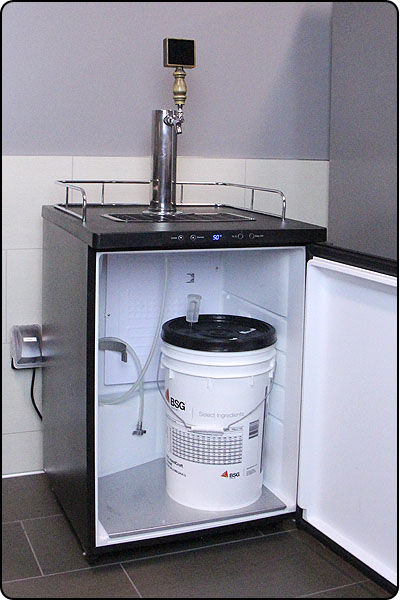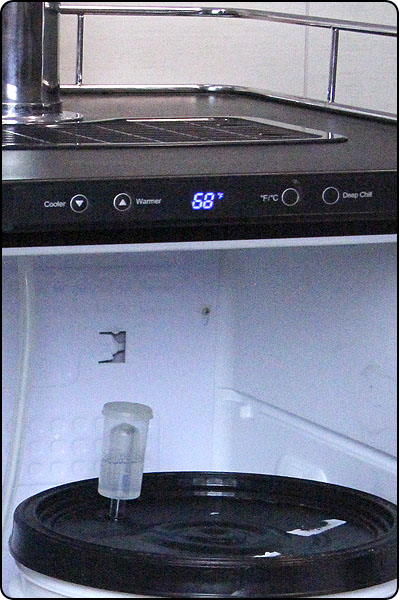
In an article on BYO Fermentation Time Line, Chris White, the president of White Labs Yeast Company, says:
"Professional breweries cool the contents of the fermenter gradually to 35° to 40° F, which forces most of the yeast to flocculate. Most home brewers do not have the facilities to do this, so they must wait for the fermenter to clear."
https://byo.com/stories/issue/item/635-fermentation-time-line
Brew like the Pros!

It no longer takes the resources of a professional brewer or the knowledge of an electrical engineer to take control of your fermentation schedule. With current technology, home brewers can now take control of the brewing process like a pro. Using a thermostat power control unit plugged into a freezer, or a kegerator with a digital read out and adjustable thermostat, you can take control of your fermentation schedule to produce clean ales, lagers or even complex beers with dynamic fermentation schedules.
A thermostat power control unit overrides an appliance's thermostat, regulating the amount of energy getting to the appliance and allowing you precise control over the temperature settings and the amount of temperature fluctuation between cooling cycles. The same concept can be used in affordable kegerators such as Kegco's K309 models. With a digital thermometer and push-button controls, the days of guessing what temperature you will get by setting a dial to 5 are over.
To give an example of how I use this technology, I recently put a five-gallon batch in a Kegco K309 kegerator for the duration of the fermentation schedule. It was a stout recipe that I have brewed a few times previously with great results. Living in San Diego, I don't have to deal with extreme temperature variations, but this past January I lost 15 gallons of pale ale due to unseasonably warm spells. I had 3 buckets that were 2 days into fermentation when they saw temperatures in the high 80's. By the time I saw the thermometer, it was 81° F. When the beer finished, it was full of unwanted esters which gave it Belgian taste.
My expectations for this batch were very high because instead of throwing a bucket/carboy in the corner, I was able to control the fermentation temperature accurately through the entire process with a kegerator.
Brewing Process

We pitched WL001 at a precisely measured 75° F and then quickly brought the temperature down to 68° F, where it stayed for 10 days. I then raised the temperature to 74° F for diacetyl rest before bringing it down to 50° F for two days. I dropped it down to 35° F for a final crash before racking it into a secondary at 35° F for a couple days until I could keg and carbonate.
The finished product did not disappoint, as it was 7.7% ABV, malty and delicious. I can't say it was noticeably better than previous batches, but it was definitely a clean stout and eliminating the chance of getting off tastes from unpredictable fermenting temps allowed me to rest easy throughout the process.
Summary
Controlling your fermentation ensures a more consistent final product and you eliminate the chance of losing a batch to unpredictable weather. It gives you one more variable to control in your homebrew process and it is a very simple to do with the right tools.
Anthony B.
Product Manager / Resident Brewer
Beverage Factory


 Single Faucet Kegerator Beer Dispensers
Single Faucet Kegerator Beer Dispensers Dual Faucet Two Tap Kegerators
Dual Faucet Two Tap Kegerators Triple Faucet Three Tap Kegerators
Triple Faucet Three Tap Kegerators Undercounter Built-In Kegerators
Undercounter Built-In Kegerators Outdoor Kegerator Beer Dispensers
Outdoor Kegerator Beer Dispensers Commercial Kegerators
Commercial Kegerators Mini Kegerators
Mini Kegerators Cold Brew & Nitro Coffee Dispenser Kegerators
Cold Brew & Nitro Coffee Dispenser Kegerators Carbonated Water Kegerators
Carbonated Water Kegerators Home Brew Kegerators
Home Brew Kegerators 15" Kegerators
15" Kegerators Kombucha Equipment
Kombucha Equipment Guinness® Dispensing Kegerators
Guinness® Dispensing Kegerators Vending Kegerators
Vending Kegerators Wine Kegerators
Wine Kegerators Kegerator Cabinets
Kegerator Cabinets Kegerator Covers and Accessories
Kegerator Covers and Accessories Kegerators
Kegerators Kegerator Conversion Kits
Kegerator Conversion Kits Kegs & Keg Accessories
Kegs & Keg Accessories Beer Faucets
Beer Faucets Beer Shanks
Beer Shanks Draft Beer Towers
Draft Beer Towers Keg Taps Couplers
Keg Taps Couplers Regulators & Gas Equipment
Regulators & Gas Equipment Beer & Gas Line Hose
Beer & Gas Line Hose Co2 and Nitrogen Air Tanks
Co2 and Nitrogen Air Tanks Beer Line Cleaning Equipment
Beer Line Cleaning Equipment Drip Trays
Drip Trays System Fittings
System Fittings Jockey Boxes
Jockey Boxes Keg Beer Party Pumps
Keg Beer Party Pumps Glassware & Accessories
Glassware & Accessories Guinness® Dispensing Equipment
Guinness® Dispensing Equipment Remote Glycol Systems
Remote Glycol Systems Wine Cooler Refrigerators
Wine Cooler Refrigerators Wine Cellar Cabinets
Wine Cellar Cabinets Wine Racks
Wine Racks Cooling Units
Cooling Units Wine Dispensing Systems
Wine Dispensing Systems Wine Glasses
Wine Glasses Wine Accessories
Wine Accessories Howard Miller Wine & Spirits Furniture
Howard Miller Wine & Spirits Furniture Wine Making
Wine Making Nitro Hot Draft System
Nitro Hot Draft System Ready to Drink Bag-in-a-Box Coffee Dispensing Equipment
Ready to Drink Bag-in-a-Box Coffee Dispensing Equipment Nitrogen Infusers
Nitrogen Infusers Nitrogen Tanks & Generators
Nitrogen Tanks & Generators Nitrogen Beer Regulators
Nitrogen Beer Regulators Nitro Cold Brew Coffee Kegs
Nitro Cold Brew Coffee Kegs Cold Brewed Coffee Tools
Cold Brewed Coffee Tools Espresso Machines
Espresso Machines Cleaning Equipment
Cleaning Equipment Outdoor Appliances
Outdoor Appliances ADA Appliances
ADA Appliances Panel Ready Appliances
Panel Ready Appliances Commercial Grade Appliances
Commercial Grade Appliances Beverage Centers
Beverage Centers Refrigerators
Refrigerators Drawer Refrigerators
Drawer Refrigerators Ice Makers
Ice Makers Water Dispensers & Accessories
Water Dispensers & Accessories Freezers
Freezers Home Brew Equipment Kits
Home Brew Equipment Kits Fermentation Equipment
Fermentation Equipment Boiling and Mashing Equipment
Boiling and Mashing Equipment Home Brew Beer Kegs
Home Brew Beer Kegs Home Brew Kegerator Conversion Kits
Home Brew Kegerator Conversion Kits Brewing Tools
Brewing Tools Home Brew Ingredients
Home Brew Ingredients Cleaning Chemicals
Cleaning Chemicals Test Equipment
Test Equipment Home Brew Beer Bottles and Bottling Equipment
Home Brew Beer Bottles and Bottling Equipment Brewery Fittings
Brewery Fittings Draft Beer Equipment
Draft Beer Equipment Homebrewing Equipment
Homebrewing Equipment Wine Equipment
Wine Equipment Luxury Appliances and Refrigeration
Luxury Appliances and Refrigeration Coffee Equipment
Coffee Equipment Home Bar & Barware
Home Bar & Barware Kombucha
Kombucha The Beverage Blog
The Beverage Blog Frequently Asked Beer Questions
Frequently Asked Beer Questions Shop by Brand
Shop by Brand Shop by Category
Shop by Category



